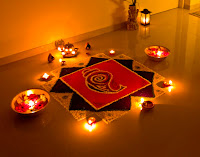Tihar Festival in Nepal is, essentially, the equivalent of Deepavali in India and other Hindu lands.
| Year | Date | Day | Holiday |
|---|---|---|---|
| 2017 | 19 Oct | Thu | Laxmi Puja |
| 20 Oct | Fri | Govardhan Puja | |
| 21 Oct | Sat | Bhai Tika | |
| 2018 | 7 Nov | Wed | Laxmi Puja |
| 8 Nov | Thu | Govardhan Puja | |
| 9 Nov | Fri | Bhai Tika |
In fact, some Nepalese even refer to it as “Deepawali”. Its timing is based on the new moon of the Hindu month Kartika, but extends two days before and after that event. Thus, it is a five-day festival. On the Western calendar, it comes in either November or October, varying year to year.
 While each Hindu ethnic group in Nepal celebrates Tihar in slightly different ways, the main outlines remain the same everywhere. The season is called “the Festival of Lights” after the clay lanterns (“diyas”) that are lit and stacked around houses every night. People use pigmented rice, flour, sand, and flower petals to make “rangoli,” which are decorative patterns on the floors of homes and outdoor areas. They are meant to honour and welcome various Hindu gods and goddesses to the home. Also of high importance is the honouring of various animals during Tihar, which will be mentioned in more detail just below.
While each Hindu ethnic group in Nepal celebrates Tihar in slightly different ways, the main outlines remain the same everywhere. The season is called “the Festival of Lights” after the clay lanterns (“diyas”) that are lit and stacked around houses every night. People use pigmented rice, flour, sand, and flower petals to make “rangoli,” which are decorative patterns on the floors of homes and outdoor areas. They are meant to honour and welcome various Hindu gods and goddesses to the home. Also of high importance is the honouring of various animals during Tihar, which will be mentioned in more detail just below.
On the five days of Tihar, the following traditions are commonly practiced in Nepal:
Day One: On this day, crows and ravens are worshiped and fed sweet foods and delicacies, which are left for them to find on Hindu roof tops. The caw-caw of the gathering crows is a symbol of sadness to Hindus, and feeding the crows is thought to prevent various calamities.
Day Two: Day two is the day of the dogs. Dogs are thought to be messengers of the god of death and are worshipped on this day every year. You will see dogs wearing wreaths, and bearing red or white dots (“tika”) on their foreheads.
Day Three: In the morning of day three, cows are worshipped. They are thought to be symbols of prosperity, and so wreaths and tika are also placed upon them. On the evening of the third day, the Hindu goddess of wealth is honoured by lighting up oil lamps in doorways and windows of homes. Music, singing, and dancing are also done door-to-door in exchange for tips. Those tipped spend the night counting up their new-found wealth.
Day Four: On the fourth day, oxen are worshipped in much the same way as the cows and dogs. Some, though not all Hindus, worship toward Goverdhan mountain on this day and make a “mini-mountain” of cow dung to represent it. Wasting nothing, even dung is commonly made use of in Nepal.
Day Five: The final day of Tihar has sisters putting tika on their brothers’ foreheads to secure for them a long and happy life. This tradition is based on the story of a Hindu goddess who did the same to her brother. At special ceremonies, sisters encircle brothers and put seven-coloured tika on their foreheads, and gifts are also exchanged.
Those who find themselves in Nepal during Tihar may wish to take part in the following activities:
- Attend the grand Tihar festival in Kathmandu. It is by far the largest and most colorful. The streets of the city will be lit profusely at night, and there will be many religious and cultural celebrations to attend. Festivals in the smaller villages are interesting for their uniqueness, while Kathmandu is easily the main attraction.
- Visit Rani Pokhari Temple, which is closed to the public all year except on the fifth day of Tihar Festival. It is in downtown Kathmandu and is located in the middle of an artificial pond. You reach the pristine, white structure by bridge, and its single dome, white-elephant carvings, and more are quite an impressive sight.
- Tour Thamel, which is a “hot tourist neighbourhood” in Kathmandu. You can travel its narrows streets on foot or by rickshaw for the “full effect” and shop at numerous quaint little stores. There is also a market, and you will find many good restaurants serving up traditional Nepali cuisine.
Nepal is an amazing land to discover, and there are few other times more well suited to exploring its people and culture than during the five days of Tihar Festival. Expect to see new sights, learn new things, and form memories that will last a lifetime.
Source From publicholidays.asia




